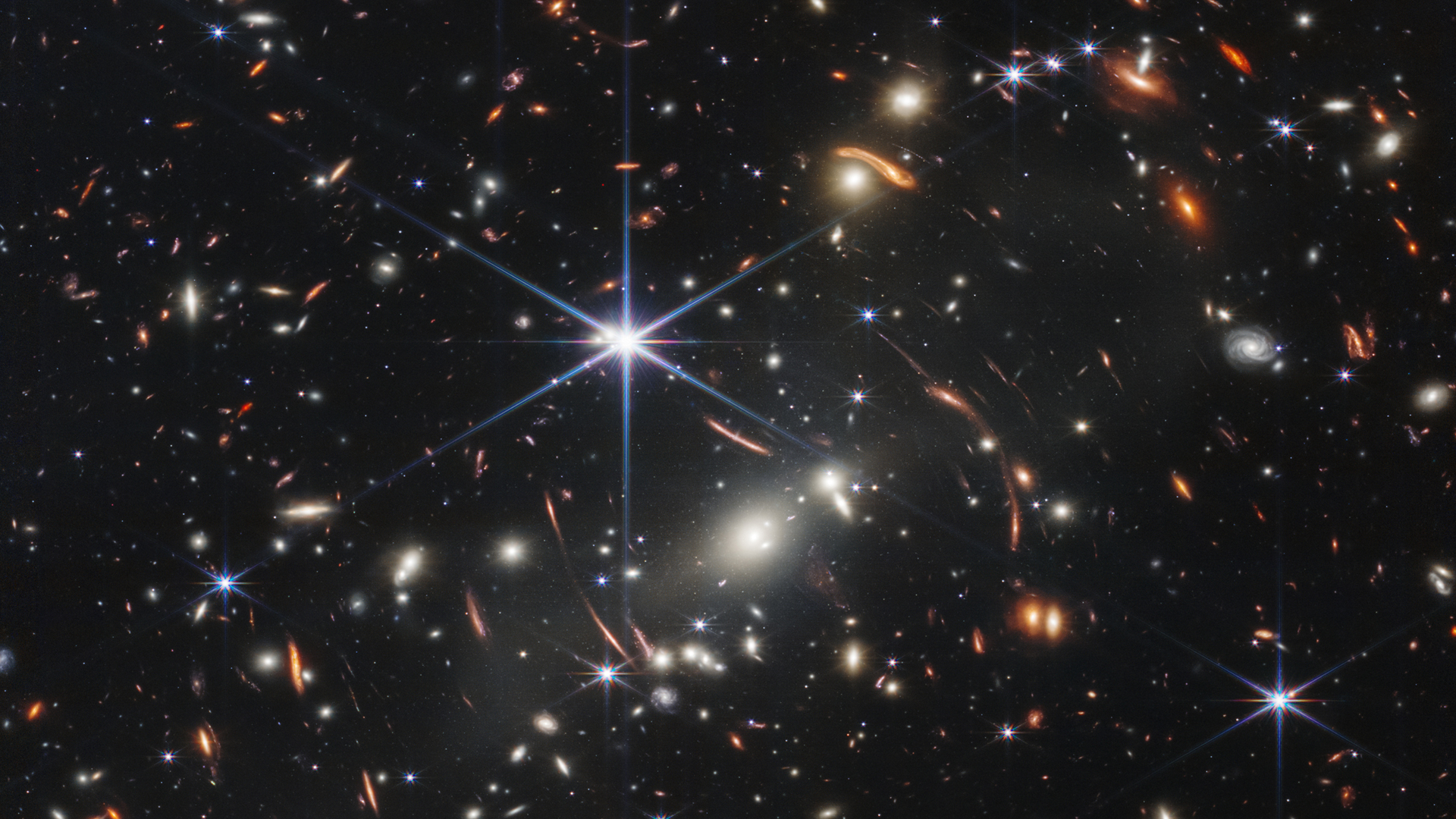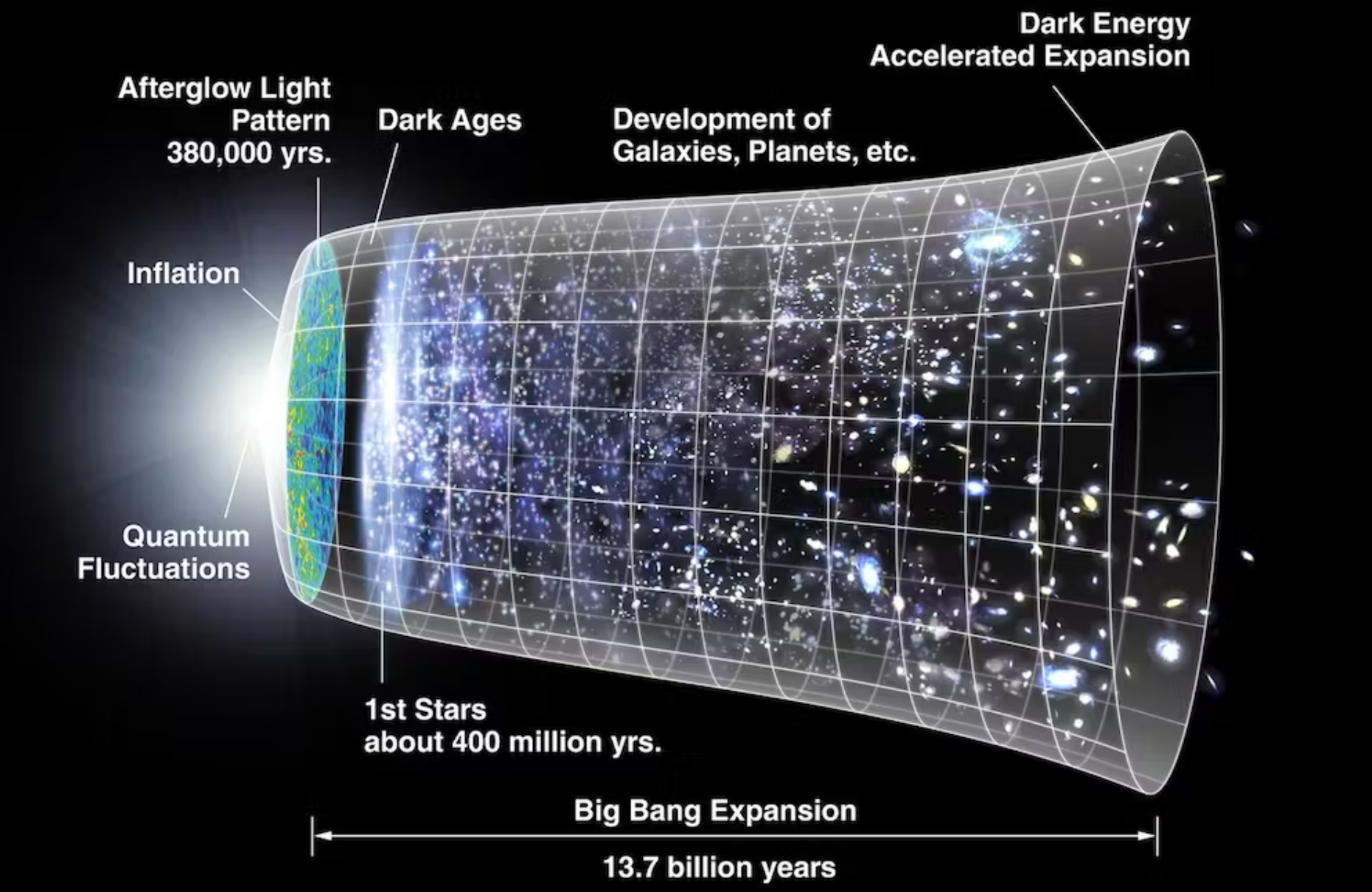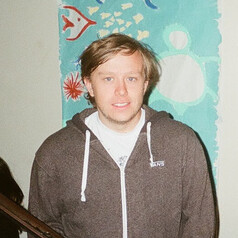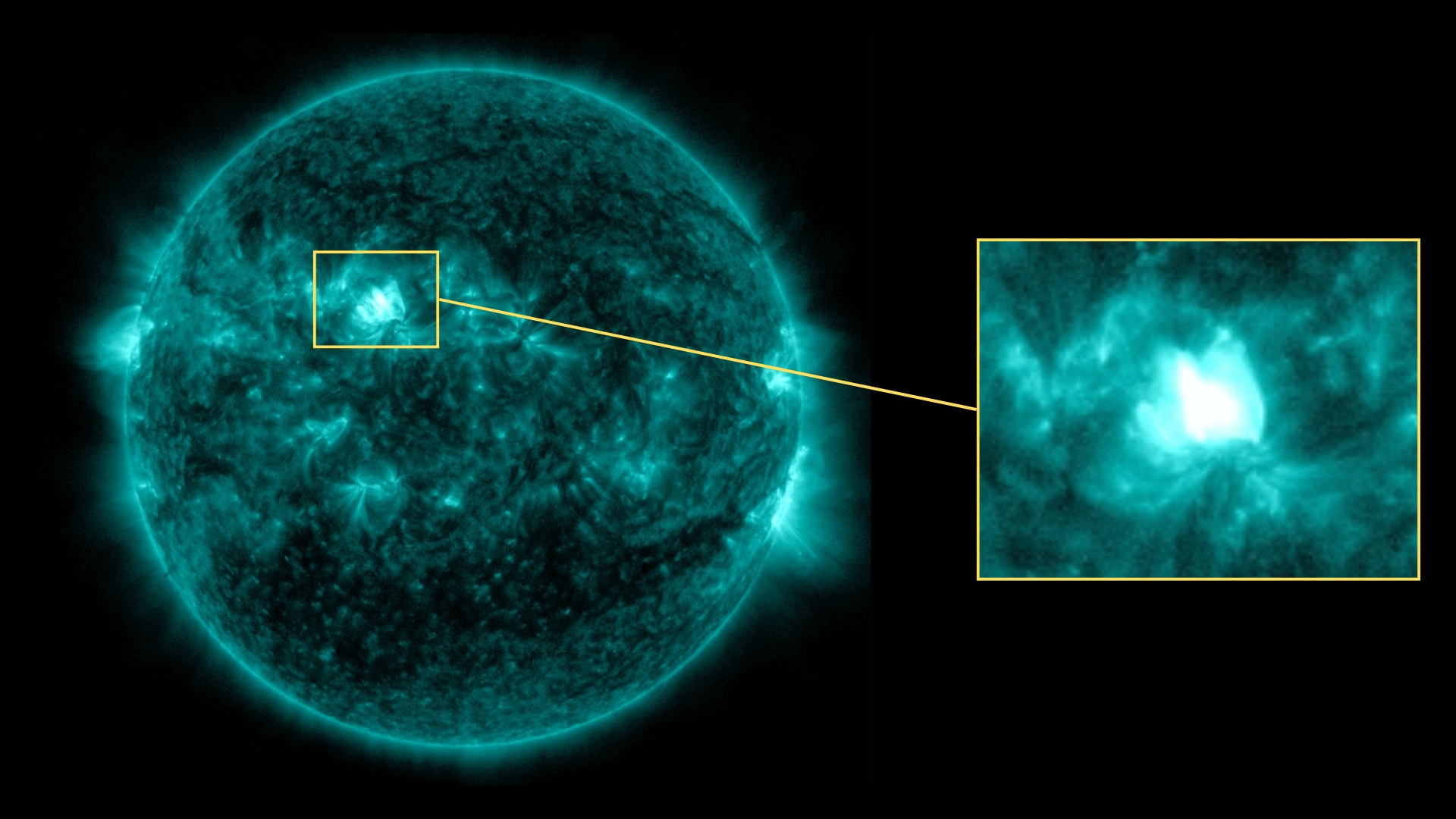
The universe is expanding faster than theory predicts – physicists are searching for new ideas that might explain the mismatch
Physicists can't explain the Hubble tension just by changing the expansion rate in the late universe – this whole class of solutions falls short.

This article was originally published at The Conversation. The publication contributed the article to Space.com's Expert Voices: Op-Ed & Insights.
Ryan Keeley is a Postdoctoral Scholar in Physics, University of California, Merced.
Astronomers have known for decades that the universe is expanding. When they use telescopes to observe faraway galaxies, they see that these galaxies are moving away from Earth.
To astronomers, the wavelength of light a galaxy emits is longer the faster the galaxy is moving away from us. The farther away the galaxy is, the more its light has shifted toward the longer wavelengths on the red side of the spectrum – so the higher the "redshift."
Because the speed of light is finite, fast, but not infinitely fast, seeing something far away means we're looking at the thing how it looked in the past. With distant, high-redshift galaxies, we're seeing the galaxy when the universe was in a younger state. So "high redshift" corresponds to the early times in the universe, and "low redshift" corresponds to the late times in the universe.
But as astronomers have studied these distances, they've learned that the universe is not just expanding – its rate of expansion is accelerating. And that expansion rate is even faster than the leading theory predicts it should be, leaving cosmologists like me puzzled and looking for new explanations.
Related: 'Hubble trouble' could deepen with new measurement of the universe's expansion
Get the Space.com Newsletter
Breaking space news, the latest updates on rocket launches, skywatching events and more!
Dark energy and a cosmological constant
Scientists call the source of this acceleration dark energy. We're not quite sure what drives dark energy or how it works, but we think its behavior could be explained by a cosmological constant, which is a property of spacetime that contributes to the expansion of the universe.
Albert Einstein originally came up with this constant – he marked it with a lambda in his theory of general relativity. With a cosmological constant, as the universe expands, the energy density of the cosmological constant stays the same.
Imagine a box full of particles. If the volume of the box increases, the density of particles would decrease as they spread out to take up all the space in the box. Now imagine the same box, but as the volume increases, the density of the particles stays the same.
It doesn't seem intuitive, right? That the energy density of the cosmological constant does not decrease as the universe expands is, of course, very weird, but this property helps explain the accelerating universe.
A standard model of cosmology
Right now, the leading theory, or standard model, of cosmology is called "Lambda CDM.' Lambda denotes the cosmological constant describing dark energy, and CDM stands for cold dark matter. This model describes both the acceleration of the universe in its late stages as well as the expansion rate in its early days.
Specifically, the Lambda CDM explains observations of the cosmic microwave background, which is the afterglow of microwave radiation from when the universe was in a "hot, dense state" about 300,000 years after the Big Bang. Observations using the Planck satellite, which measures the cosmic microwave background, led scientists to create the Lambda CDM model.
Fitting the Lambda CDM model to the cosmic microwave background allows physicists to predict the value of the Hubble constant, which isn't actually a constant but a measurement describing the universe's current expansion rate.
But the Lambda CDM model isn't perfect. The expansion rate scientists have calculated by measuring distances to galaxies, and the expansion rate as described in Lambda CDM using observations of the cosmic microwave background, don’t line up. Astrophysicists call that disagreement the Hubble tension.

The Hubble tension
Over the past few years, I've been researching ways to explain this Hubble tension. The tension may be indicating that the Lambda CDM model is incomplete and physicists should modify their model, or it could indicate that it’s time for researchers to come up with new ideas about how the universe works. And new ideas are always the most exciting things for a physicist.
One way to explain the Hubble tension is to modify the Lambda CDM model by changing the expansion rate at low redshift, at late times in the universe. Modifying the model like this can help physicists predict what sort of physical phenomena might be causing the Hubble tension.
For instance, maybe dark energy is not a cosmological constant but instead the result of gravity working in new ways. If this is the case, dark energy would evolve as the universe expands – and the cosmic microwave background, which shows what the universe looked like only a few years after its creation, would have a different prediction for the Hubble constant.
But, my team's latest research has found that physicists can't explain the Hubble tension just by changing the expansion rate in the late universe – this whole class of solutions falls short.
Developing new models
To study what types of solutions could explain the Hubble tension, we developed statistical tools that enabled us to test the viability of the entire class of models that change the expansion rate in the late universe. These statistical tools are very flexible, and we used them to match or mimic different models that could potentially fit observations of the universe's expansion rate and might offer a solution to the Hubble tension.
The models we tested include evolving dark energy models, where dark energy acts differently at different times in the universe. We also tested interacting dark energy-dark matter models, where dark energy interacts with dark matter, and modified gravity models, where gravity acts differently at different times in the universe.
But none of these could fully explain the Hubble tension. These results suggest that physicists should study the early universe to understand the source of the tension.
This article is republished from The Conversation under a Creative Commons license. Read the original article.
Join our Space Forums to keep talking space on the latest missions, night sky and more! And if you have a news tip, correction or comment, let us know at: community@space.com.

I do research in the fields of both astroparticle physics and cosmology, and I specifically focus on developing statistical tools to test LambdaCDM, a theory known as the standard model of cosmology. As a cosmologist, I use observations of astrophysical systems, like galaxies, to test our understanding of the fundamental laws of physics. As an astroparticle physicist, I work to identify the particle nature of dark matter and how it might interact with the standard model of particle physics. I’ve worked on developing tests of dark matter, dark energy, inflation, and modified gravity.
I am am a postdoctoral researcher at the University of California, Merced working with Anna Nierenberg. I also have an associate member status at the Center for the Gravitational-Wave Universe. I was a postdoctoral researcher studying cosmology at the Korea Astronomy Space Science Institute with Arman Shafieloo. Previously, I earned my PhD at UC Irvine working with Kevork Abazajian and also collaborating with Manoj Kaplinghat.
-
Tiffany4891 Reply
Here's a thought: I would suggest that not only was matter born during the "Big bang", but also more cells of "negative space"--black holes; black holes that will eventually be all that's left of our smaller universe, made up of matter. And those new cells of anti-mater (the newly formed black holes) will eventually be absorbed into the greater, outer universe of negative space, in a never-ending cycle of birth, life, and death of universes. This idea occurred to me sixty years ago, at the age of twelve, while wrestling with the question of “How can the universe go on and on forever; yet, how might it possibly ever end or have an edge--because there would have to be "something" on the other side of any "edge". Similar to when I figured out that there was no Santa Claus, for want of understanding, I assembled the notion that there might be a much larger mega-universe than we’ve detected: one primarily and overwhelmingly made up of what I then called “negative space.” That space, to my way of thinking, was the opposite of matter–I referred to it then as "anti-matter" and considered it to be much like a vacuous void with immeasurable gravitational force, but different than the emptiness of space here in our known universe. As I grew older (and as an adoring fan of Carl Sagan and his visions of our place in the universe), it became known to me that the universe was expanding, which seemed in keeping with an explosion or chemical reaction such as was the big bang (not unlike, in my mind, a match that had been struck); however, it was determined that it was not slowing down as it progressed through its ignition and expansion--like any other kind of explosion--and was, instead, speeding up. Needing to fit this into my sense of what the laws of physics throughout the universe must be, I decided that our universe could be surrounded by this dark, undetectable, vacuous space, and that it must be pulling outward on the remnants of that big bang. When dark holes were discovered, they fit perfectly in with my youthful attempt to make sense of it all as these new entities acted much like the negative space or anti-matter I had imagined as a boy. I supposed that those black holes found here within our galaxies were only single cells--fragments of what might surround us entirely (a vacuum so powerful as to defy our imaginations: less than nothing: absolute infinite nothingness). More recently, I’ve decided that my theory has not been dispelled by the discoveries of our time, but has, to the contrary, been continuously supported by our growing understanding of the world. I suggest that 99.9999999 percent of the universe is just what I’ve described: negative space; anti-matter. Not "nothing", but a dark force much more powerful than anything we've ever witnessed. This space, larger than anything we’ve previously imagined, might be made up entirely of what we know as black holes--only larger than the mind can dream--making that negative space the actual fabric that our whole mega-universe consists of. I don’t know if anyone has considered it, but try to imagine what a box filled with black holes would look and act like, and then compound that outward for many miles, and then throughout infinite space. This space would dominate the mega-universe, allowing no matter to exist within it, with the exception of small bubbles of fiery chemical reactions known to us as "universes", and the energy left over from the annihilation and complete absorption of these universes, which leave behind only newly-born black holes and what is now referred to as “Hawking’s radiation.” In my theory–just as with black holes–that radiation cannot be consumed or annihilated by negative space, and exists as only thin streams of light or energy, like lightning bolts which are constantly being pulled apart by the surrounding negative energy, and (like drops of oil in an ocean), tending to find each other and to build again into new, fast-moving lightening bolts of radiation. In this vision, I imagine that those streams of cosmic radiation occasionally run into each other head-on, and cause a chemical reaction, an explosion of sorts; one which would be like the striking of a match, with one exception: after impact, as the elements are reacting and forming new elements and are burning up, the greater mega-universe is also pulling the small envelope of energy and matter apart, faster and faster, until it’s once again absorbed into the tremendously larger outer mega-universe. These small “big bangs” (universes being born) might occur quite regularly, but would only be a small flicker--only lasting a very short time in the really grand scheme of things. I understand that it takes some imagination and an open mind to grow one's vision of the universe so big as to imagine that large of a black canvass--one in which the collisions of small bolts of undying radiation–leftovers from the birth, life, and death of universes–might occur. These random collisions of lightning bolts are my estimation of how the big bangs might happen in that mega-universe, suggesting that our universe is actually infinitesimally small (all things considered), and that there is a never-ending cycle and an infinite number of “universes” being born, living, and dying in an enormous negative space, far more vast than what lies within the envelopes of our "universes", our material-filled bubbles. And so...what's at the edge of the universe in this hypothesis? There answer is that there is no edge...only completely dark, vacuous, tremendously powerful, negative space. A Great Nothingness---more powerful than anything made up of matter. I can’t imagine how the mathematics of a box of black holes might work out, but in my uninformed attempt to make the universe go on forever, it’s the only thing that makes any sense to me. It’s a much larger vision of the mega-universe: one filled with tiny “universes” that are busy about their blazing chain-reactions--each of them only temporary fireflies in an incredibly large sky of true blackness; where only the light of Hawking’s radiation might exist, and then only to go through an endlessly repeated process of exploding into matter which is slowly annihilated and reverted back into its original, basic form: radiation, only to be once again absorbed into the greater, surrounding mega-universe. Within this tremendous void I also imagine areas where even greater negative energy accumulates into truly vast “holes” within that negative space–truly enormous gatherings of negative space–an empty place where neither these lightening bolts of cosmic radiation nor these small bubbles of universes can exist. These areas might somehow help to explain the “waves” of extreme gravitational force we’re now starting to detect. Thusly, just as there are billions of suns in a galaxy, and billions of galaxies in a universe, there might be billions of universes in my mega-universe: each of them simply being created by leftover radiation generated from earlier chemical reactions--earlier big bangs. I’d be very surprised if there wasn’t a plethora of laws in physics which put my notion asunder, but I’m very happy to have shared it, and I hope that it brings everyone a small amount of pleasure in its simplicity. I'm just saying...Admin said:The universe is not just expanding – its rate of expansion is accelerating. And that expansion rate is even faster than the leading theory predicts it should be, leaving cosmologists puzzled.
The universe is expanding faster than theory predicts – physicists are searching for new ideas that might explain the mismatch : Read more -
rod space.com forums in the recent past posted reports on the Hubble constant and issues with how fast space may or may not be expanding. Many other reports are out too on this in the BB model.Reply
https://forums.space.com/threads/how-fast-is-the-universe-expanding-new-supernova-data-could-help-nail-it-down.61362/
https://forums.space.com/threads/james-webb-space-telescope-deepens-major-debate-over-universes-expansion-rate.63114/
